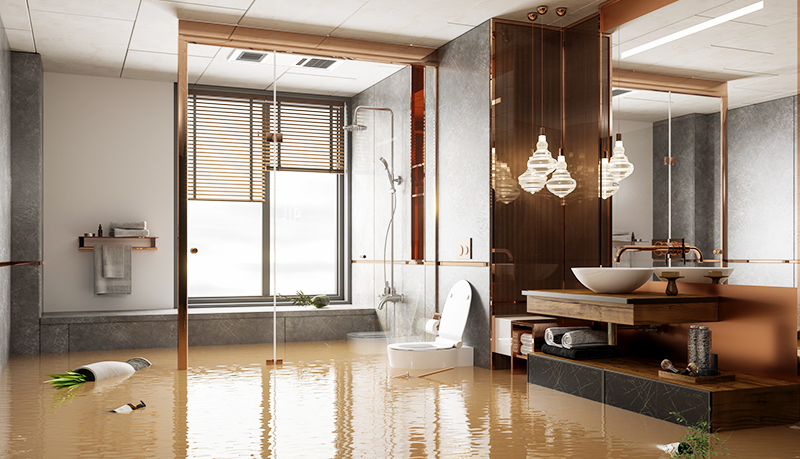A Common Claim Explained: Water Loss
Read in 6 minutes

Too often we have seen a minor drip turn into a major headache. Whether from a burst pipe, a defective ice machine or a leaky faucet, water loss is the second-most common claim made by our clients.
In fact, one of our carriers has found non-weather-related water trouble to be the primary source of interior property damage, resulting in almost half of such claims and, on average, a three-month dislocation. Another of our carriers, sees it as the main cause of loss in luxury homes, more common than weather-related flooding, fire or theft. Compounding this hazard is the fact that once a problem arises, homeowners are twice as likely to suffer more.
Yet, water loss is by no means an inevitable occurrence. The following guide explains the eight most important things to know about dealing with water damage.
1. Damage caused by weathered-induced floods is not considered “water loss.”
We have written about this before but it bears repeating because it can be confusing and is quite consequential: Damage due to rising water from heavy rains, hurricanes and other weather events is only covered by flood insurance, not homeowners insurance. Because of the increase in such situations—not least, in previously unaffected regions—we now recommend that all homeowners include flood coverage in their insurance program.
2. Aging urban infrastructure is prone to significant water loss, and it’s not always clear who is responsible for covering the damage.
Typically, the building is liable for anything that occurs behind the walls and unit owners or shareholders are responsible for anything that happens inside their individual apartments, but this arrangement is dependent on the governing agreement and thus varies. In any case, it can be hard to ascertain exactly where a leak emanates from. Worse, even if you know water is coming from your upstairs neighbor’s apartment, you still have to prove their negligence, and that is a high bar; something like failing to attend to a toilet that begins to run continuously doesn’t make the cut. (A destructive party or faulty renovation, on the other hand, might.) Whatever the cause, you will most likely need to file a claim with your broker, who will work with your carrier to then subrogate to the other homeowner’s policy, if possible.
3. Southern homeowners now must consider the possibility of freezing temperatures.
Most residences in states like Texas and Tennessee were not built to handle major mercury dips. Meanwhile, flash freezes—and the pipe bursts that often result from them—have become more likely. If you live in these newly susceptible areas, it is worth discussing preventative measures like adding water shutoff devices and a low temperature monitor with a contractor. Similarly, if you are embarking on a major renovation or rebuild after a loss, be sure to incorporate the same precautionary measures used in northern homes, such as, insulating exterior-facing pipes.
4. Use best practices to attach appliances to water lines.
Washing machines, dishwashers and refrigerators—not to mention sinks, showers and toilets–are major perpetrators of water damage. Whether you live in an apartment or house, make sure contractors and installers use top-quality hoses and piping as well as the hardware that attaches it to the plumbing. Though workers often default to more cost-effective materials, asked-for upgrades should not add significantly to your cost. It can be well worth the expense.
5. Modern conveniences can cause inconvenient damage.
With advances in smart technology comes the increased potential for problems. We regularly see damage caused by stand-alone icemakers, touchless faucets and other sensor-enabled appliances. If you want this kind of equipment in your home, make sure you also incorporate a shut-off device (see below).
6. Smart technology can also prevent leaks.
Automatic shut-off devices are one of the best ways to protect your home. Installed by a plumber, they monitor typical water usage and automatically cut the flow when something unusual is detected. They also send alerts to your smartphone, so you can respond to the issue quickly, even if you are away. Similarly, you can install point-of-leak sensors under kitchen faucets, in bathrooms and anywhere else that water damage is likely to occur. Many monitor humidity and temperature, too. Low-temperature monitors are especially crucial in colder climates, alerting you or your caretakers to raise the heat if need be to prevent pipes from freezing. Note: Many carriers offer premium discounts to those who install such precautionary tools.
7. Addressing leaks immediately keeps mold from becoming a secondary issue.
You can not see what is transpiring behind your walls; what looks like a manageable amount of damage on the outside can be building up to a massive mold problem on the inside. It’s crucial to bring in a remediation company after any water event to dry out everything sufficiently so the problem doesn’t grow out of hand. That can happen fast, especially in humid climates.
It’s important to note that mold damage independent of a water loss is excluded on most homeowners policies. In fact, typically only a minimal amount of coverage is included for mold that forms due to a covered water loss. Depending on your state and carrier, higher limits could be available and should be added to your program. Be sure to consult with your broker about what options and limits might be available to you.
8. It may not pay to put in a claim for water loss.
Statistics show that if you sustain one water loss there is a high probability another is to follow, and a pileup of offenses can present as an undesirable profile to an insurance carrier. The result: higher premiums or, worse, a nonrenewal. If you undergo water-related damage, contact your broker immediately to discuss next steps. If, for example, you have $15,000 worth of damage but a $10,000 deductible, it may make more sense to pay out of pocket rather than add the loss to your claim history. This is always a case-by-case calculation, though, so consult with your insurance professional.
If there is a silver lining to the worrisome ubiquity of water loss, it is that we have become experts at handling it. Should you have any questions about prevention or coverage, don’t hesitate to reach out.




